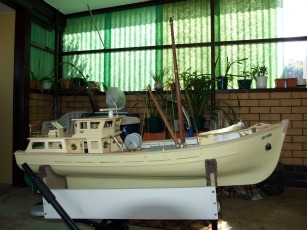RC boat electronics
by Gilbert
(Tasmania. Australia)
I have built a model boat which is 1.2 meters in length and I am up to the fitting of the electronics. Problem is, I have no idea about electronics. I have tried to get information but people are reluctant to give any. I need an electric motor, radio transmitter and receiver, ESC speed control. Could you tell me what I want for the job. Thank you.
From your question I'll assume you know the hardware end of things, so I'll leave that out of the discussion. From what it sounds like, here is what you need:
- Motor:
- You need to figure out your power needs. I wrote a page about sizing the power of a model boat motor. I'm guessing 60 to 120 Watts would be sufficient. I'm guessing a Graupner 600 with integrated gearhead could be a good place to start if you can find a place that sells them. Unfortunately, surplus motors in this range are rare, but it can't hurt to look around.
- As I mentioned, you'll need a geared motor. Depending on your propeller, most electric model boats do best with 1,000 to 4,000 RPM at the shaft at full gusto. The bigger the model, the lower the RPMs typically. This also differ by boat type and scale so use the numbers as a guide only. To accomplish this you need a gearbox between the motor and propeller shaft. You can build your own, but it is much more convenient and probably less expensive to get a geared motor. Aim for 2:1 to 4:1 gear ratio.
- RC Battery Packs:
You've got plenty of options here but the best choice, in my opinion is to use a NiMH pack. They are reasonably priced and the market is full of good options. The buoyancy of your model could easily handle a lead acid cell, I'm sure. Problem is, lead acid puts out a lot of voltage with little or no load. Most ESCs can't handle more than 12V, so you'll be chancing the life of your ESC.
- ESC:
- You want to make sure it comes with Reverse.
- It must be able to handle the max voltage of the RC battery pack plus a margin.
- It needs to be able to handle the maximum current your motor will draw under normal use.
- There is usually a mention of "numbers of turns" on the motor. If you're using stock motors, you have nothing to worry about.
- Consider the connector type on your battery pack: Tamiya, Kyosho or Traxxas. There are adapters, but it's so much better to plug-and-play.
- Watertight is a plus.
- ESCs these days come with a BEC (Battery Elimination Circuit). Essentially a power drop to your radio. The era of always having separate batteries for your receiver is now gone. Having said that, some feel having separate power is a good thing, so your choice.
- I'd highly recommend a potted ESC, such as the Pro Boat PRB2314. It is rated at 40 amp continuous. At 120W and 8.4V that comes out to 14.3A - plenty of head room.
- Radio:
- I believe the 2.4GHz radios are here to stay.
- Get a FHSS (Frequency Hopping Spread Spectrum) radio.
- Stick or wheel depending on your preference and number of channels you feel you need.
- Most radios no longer come with servos. Your boat would probably do well with a standard servo for steering. Click here for more on RC servos.
- I recently purchased a Tactic TTX404 and I'm very happy so far. It feels a little "plasticky", but at this price I think it's the best in its class.
- Other
You can add other specialized electronic modules. The most common are running lights, motor sound, pumps etc. Running lights can be connected through a manual switch somewhere on the model. The others are generally more involved and ought to be on it's own channel or piggy-backed off another channel using a Y-cable. I feel that going any deeper is beyond the initial question.






